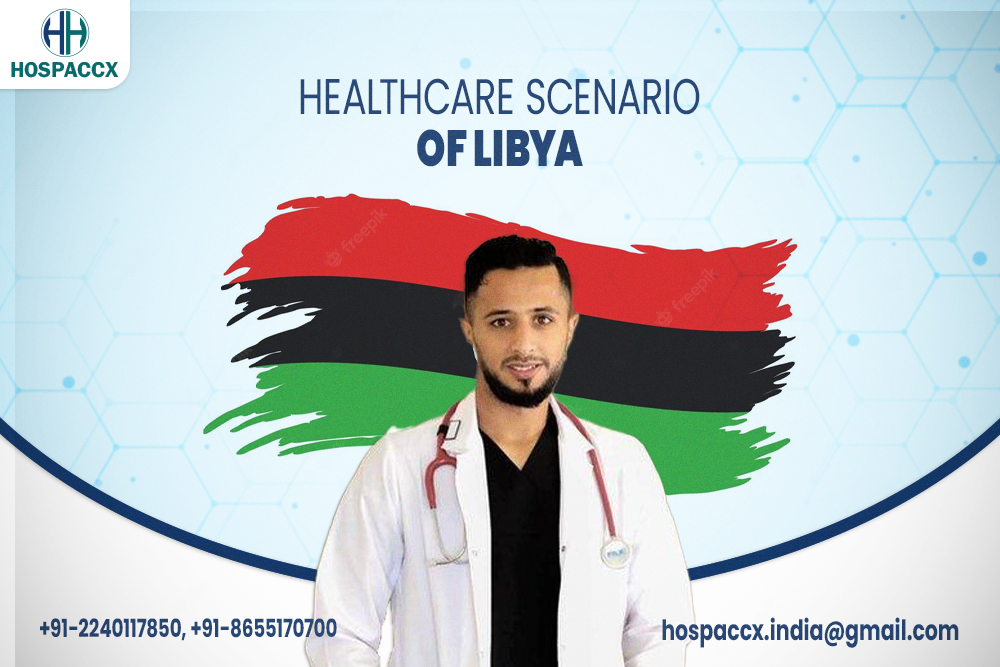Are you planning to build or restructure or venture in any healthcare venture in Libya? Looking for information about the major healthcare players in government, and private diagnostic centers that are available in Libya? Are you looking to find out which part of the cities is best to venture into or what all facilities are available and what should be planned for the new setup? In this article, Hospaccx Healthcare Consultancy has mapped all on major players in terms of medical facilities and the healthcare scenario of Libya.
OVERVIEW OF THE COUNTRY
Libya, a mostly desert oil-rich country, has become a key springboard for migrants heading for Europe, and a source of international tension as rival governments in the west and East seek to establish nationwide control. Libya was under foreign control for centuries until it gained independence in 1951. Soon after, oil was discovered and earned the country immense wealth.

DEMOGRAPHIC PROFILE
- The current population of Libya is 7,136,201.
- Libya’s population is equivalent to 09% of the total world population.
- Libya ranks number 108 in the list of countries (and dependencies) by population.
- The population density in Libya is 4 per Km2 (10 people per mi2).
- The total land area is 1,759,540 Km2 (679,362 sq. miles)
- 2 % of the population is urban.
- The median age in Libya is 28.8 years
HEALTH INDICATORS

HEALTHCARE FINANCING
Libya spends approximately about six billion Libya dinars (USD 4.7 billion as per the official exchange rate) on the health sector every year. A part of these expenses goes to the salaries of those working in the health sector and another part goes to the maintenance of buildings, devices, and equipment.
In 2023, UNICEF requires US$28.6 million to provide children and families in Libya with life-saving humanitarian assistance. These funds will help UNICEF to maintain key health and nutrition programs for 174,000 women and children and provide essential WASH supplies to 112,500 people. UNICEF aims to reach 469,000 children and caregivers with essential mental health and psychosocial support and other critical specialized child protection services and to ensure that 96,000 children have access to learning opportunities. UNICEF will also provide support to the transition from humanitarian to development assistance.
HEALTHCARE INFRASTRUCTURE

Currently, the private health sector consists of 537 outpatient centers, 235 inpatient centers, 371 dental clinics, 3089 pharmacies, 411 laboratories, and 19 diagnostic imaging centers.

Currently, the public sector consists of 97 hospitals, 56 polyclinic, 571 healthcare centers, 31 dialysis centers, 51 ambulance centers, 27 NCDC branches, and 728 primary healthcare units.
The National Strategy for Primary Healthcare 2023-2028 aims to improve the efficiency of the first level of healthcare services in Libya. This is essential as primary healthcare is the backbone of any healthcare system and serves as the first point of contact for patients seeking medical care. The strategy will focus on enhancing the quality of medical services provided by group clinics, health centres and units, and implementing family medicine and a referral system. The strategy aims to provide comprehensive and accessible healthcare services to all citizens, regardless of their location or socio-economic status.
The National Strategy for Primary Healthcare 2023-2028 will be implemented in three phases, with each phase covering all regions of Libya. The implementation of this strategy will result in the adoption of a unique health number for each citizen, which will enable the creation of an electronic health record for each patient.
CURRENT HEALTHCARE SUPPORT SCENARIO FROM UNICEF IN LIBYA (2023)

MAJOR HOSPITALS IN LIBYA
- Tripoli Central Hospital
It is a teaching hospital and a trauma center. It is the second-largest hospital. It houses the city’s main and oldest trauma center as well as Libya’s first and only organ transplantation program.
- Libyan European Hospital
The Libyan European Hospital is a private venture. It is a 150 bedded hospital aiming to provide the Benghazi region with a high standard of private healthcare. The hospital provides medical care on a secondary level with all common medical specialties such as Internal Medicine, General Surgery, Cardiology, Gynaecology/ Obstetrics, Pediatrics, ENT, Ophthalmology, Urology, Physical Medicine & Rehabilitation, Dermatology, Plastic & Reconstructive Surgery, Neurology, Dentistry, Oncology, and Orthopaedics.
- Saint James Hospital
The hospital was first opened in 2006. It is a 50-bed multidisciplinary hospital. The main services they offer are; a comprehensive laboratory, OT, endoscopy theatre, dental and implantology unit, GP services, Radiology clinic, etc.
- Ibn Sina Cardiac Hospital
It was established in 1980. It is the only cardiac hospital in the country. It also has a trauma center and a 100 bedded hospital out of which 65 are in operational service.
- Libyan German Hospital
The Libyan German Hospital is a 60 beds intensive care, general medical, and surgical hospital situated in Benghazi, Libya.
CONCLUSION
The healthcare scenario in Libya is characterized by significant challenges stemming from infrastructure damage, limited access, and inadequate resources. However, by focusing on rebuilding infrastructure, improving access to care, strengthening the quality and public health programs, implementing sustainable financing mechanisms, and promoting stability and governance, Libya has the potential to make substantial progress in its healthcare sector and improve the well-being of its population.
Above is the superficial and macro level study for in-depth market and financial feasibility studies or any other healthcare-related research needs, please feel free to reach out to us at +91-8655170700 or email us at hospaccx.india@gmail.com . Our team is equipped to provide comprehensive and detailed insights tailored to your specific requirements.
Related Team Members











